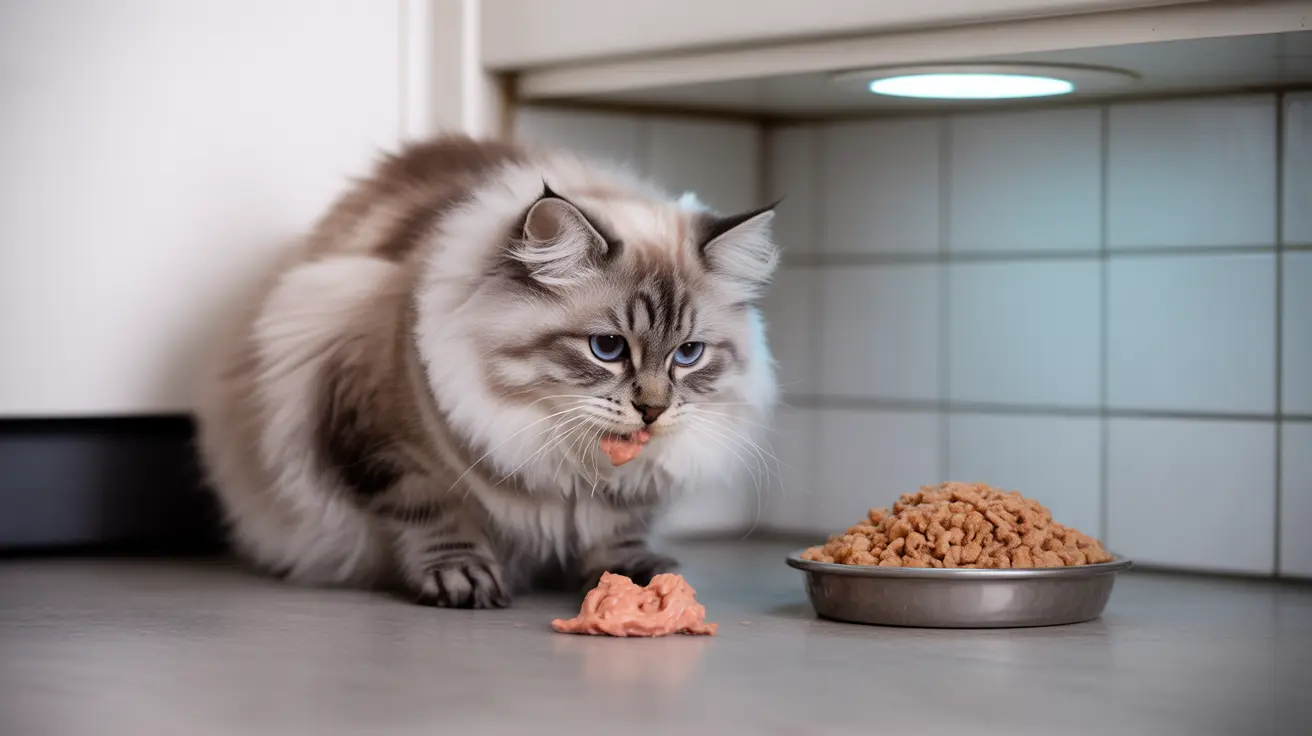Understanding Cat Regurgitation vs. Vomiting: The Basics
Regurgitation is a passive process where undigested food returns from the esophagus shortly after eating. It happens quietly, with little warning and minimal effort from your cat. The regurgitated material typically appears tubular and is covered in saliva or mucus.
In contrast, vomiting is an active, forceful process that expels partially digested food from the stomach or upper intestines. It's usually preceded by signs of nausea like drooling and lip-smacking, followed by visible retching and abdominal contractions.
Common Causes of Cat Regurgitation
Behavioral and Environmental Factors
Many cases of regurgitation are linked to eating habits and environmental factors:
- Eating too quickly
- Consuming too much food at once
- Competition stress in multi-cat households
- Drinking large amounts of water after meals
- Consuming food that's too hot or cold
Medical Conditions
More serious causes of regurgitation can include:
- Esophageal obstruction
- Megaesophagus
- Congenital abnormalities
- Esophageal strictures
Identifying Vomiting in Cats
Vomiting has distinct characteristics that set it apart from regurgitation:
- Active abdominal contractions
- Presence of yellow or green bile
- Partially digested food
- Can occur any time, not just after meals
- Often accompanied by other symptoms like lethargy or appetite changes
When to Seek Veterinary Care
While occasional regurgitation might not be serious, certain signs warrant immediate veterinary attention:
- Frequent episodes (more than once monthly)
- Weight loss
- Lethargy
- Concurrent vomiting or diarrhea
- Difficulty breathing
- Loss of appetite
Prevention and Management Strategies
For Regurgitation
Try these practical solutions for cats prone to regurgitation:
- Use puzzle feeders or slow-feed bowls
- Serve smaller, more frequent meals
- Keep food at room temperature
- Create separate feeding stations in multi-cat homes
For Vomiting
To manage vomiting tendencies:
- Maintain a consistent diet
- Implement gradual food changes
- Use hairball prevention methods
- Keep toxic plants and substances out of reach
Frequently Asked Questions
What are the key differences between cat regurgitation and vomiting?
Regurgitation is passive, occurs shortly after eating, and involves undigested food coming up from the esophagus. Vomiting is active, involves abdominal contractions, and brings up partially digested food or bile from the stomach or intestines.
How can I tell if my cat is regurgitating or vomiting after eating?
Watch for timing and effort. Regurgitation happens quietly and quickly after eating, with undigested, tube-shaped food. Vomiting involves retching, drooling beforehand, and produces partially digested food, often with bile.
What common causes make cats regurgitate food shortly after meals?
Common causes include eating too quickly, overfeeding, stress during meals, drinking too much water after eating, and food temperature issues. Medical conditions like esophageal problems can also cause regurgitation.
When should I be concerned and take my cat to the vet for regurgitation or vomiting?
Seek veterinary care if you notice frequent episodes, weight loss, lethargy, difficulty breathing, or if regurgitation is accompanied by vomiting or diarrhea. Any sudden increase in frequency also warrants attention.
What home management tips can help reduce my cat's regurgitation due to eating habits?
Use slow-feed bowls or puzzle feeders, serve smaller meals more frequently, ensure food is room temperature, and create a calm feeding environment. In multi-cat homes, provide separate feeding stations to reduce competition stress.






